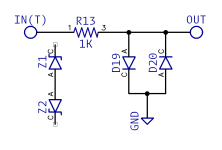Further to my wondering whether we are analysing diodes a little deceptively, I thought I would test the transfer function, as that's what we're actually interested in at the end of the day? You can see some interesting data in this interactive plot. https://sites.google.com/view/smallaudiodesign/diode-transfer-functions
This was my test setup. Audio interface with 0dBfs = +19dBu output, circuit, Audio interface input 0dBfs = +19dBu. The data was generated using the plugin doctor dynamics analyser with the data transformed to a voltage. Unfortunately this results in a loss of resolution at higher voltage due to the fact it runs in discrete dBfs steps, which obviously as you get closer to 0 represents ever larger steps in voltage.

I think one thing is though, softness is really not a discreet property right? The amount of current will affect it of course. But also, the total magnitude of the input signal. What really matters is what proportion of your signal is affected by the soft part of the knee. A BAT41 will sound quite soft in the above circuit config if you limit the peak voltage of the signal to say 1v. But if the signal peaks at 3v, it will sound quite hard as only a very small proportion of the overall signal is passing through the "soft" region.
I think as was mentioned in the thread I linked to originally, the data needs to be normalised so that all non-linnear regions are compared at a virtual zero starting point.
Further investigation will include diode stacking / mixed stacking.
This was my test setup. Audio interface with 0dBfs = +19dBu output, circuit, Audio interface input 0dBfs = +19dBu. The data was generated using the plugin doctor dynamics analyser with the data transformed to a voltage. Unfortunately this results in a loss of resolution at higher voltage due to the fact it runs in discrete dBfs steps, which obviously as you get closer to 0 represents ever larger steps in voltage.

I think one thing is though, softness is really not a discreet property right? The amount of current will affect it of course. But also, the total magnitude of the input signal. What really matters is what proportion of your signal is affected by the soft part of the knee. A BAT41 will sound quite soft in the above circuit config if you limit the peak voltage of the signal to say 1v. But if the signal peaks at 3v, it will sound quite hard as only a very small proportion of the overall signal is passing through the "soft" region.
I think as was mentioned in the thread I linked to originally, the data needs to be normalised so that all non-linnear regions are compared at a virtual zero starting point.
Further investigation will include diode stacking / mixed stacking.
I've been reading up on diode softness and curve tracing and all that kind of stuff. 2 threads in particular have made me question some of our understanding of practicalities of measuring the softness of the clipping/conduction knee.
Take this thread for instance on MOSFET clipping, in this case the more interesting Gate to Drain type, not the Gate to Source type where it's essentially just a regular diode.
On the graph the MOSFET looks like it would clip softly, except actually the only holds true at high current, which we might not often actually ever encounter in a pedal. At pedal...
Take this thread for instance on MOSFET clipping, in this case the more interesting Gate to Drain type, not the Gate to Source type where it's essentially just a regular diode.
On the graph the MOSFET looks like it would clip softly, except actually the only holds true at high current, which we might not often actually ever encounter in a pedal. At pedal...
- rossbalch
- Replies: 7
- Forum: General Questions
